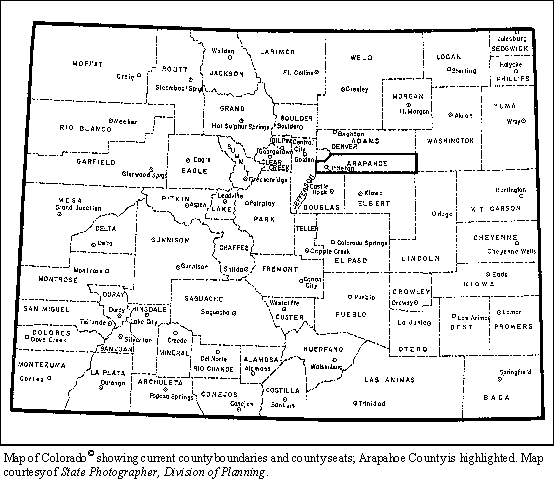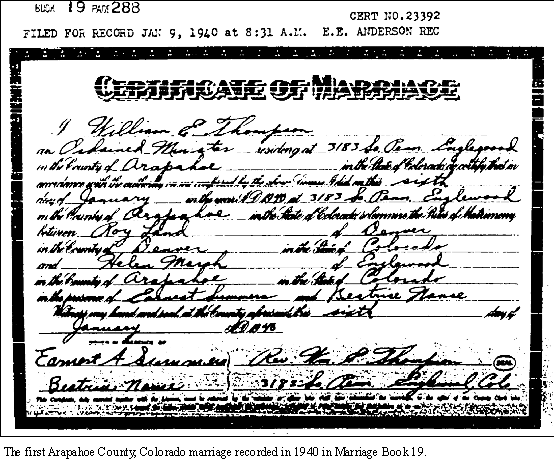Introduction
“Arapahoe
County is Number 1.” This message painted on the sides of
Arapahoe
County trucks refers to its history. The origin of
Arapahoe
County dates back to the time of
Kansas
Territory
established on 30 May 1854 by the U. S. Congress.
Arapahoe
County, created in 1855 as a much
larger county in
Kansas
Territory, was named in honor of the friendly tribe of
inhabitants known as the Arapaho. The county stretched from the Continental
Divide eastward across unorganized territory to the 103rd meridian.
In 1859, this area was
divided into six counties, and Arapahoe
County had a north-south orientation as opposed to its later
east-west orientation. On
28 February 1861,
Colorado
Territory was carved out of portions of
Nebraska
Territory,
Kansas Territory,
New Mexico
Territory, and
Utah
Territory.
Kansas
became a state on
29 January 1861, a month before the birth of
Colorado
Territory. Thus, for thirty days, a portion of eastern
Colorado was not in any Territory and was technically a part
of the unorganized public domain. On 1 August 1876,
Colorado
was admitted to the Union as the “Centennial
State” and the current eastern boundary was established.
The area was then divided into seventeen counties plus an Indian Reserve established for
Cheyenne and Arapaho. Some time later,
the Indian Reserve was closed by treaty and the inhabitants moved to
Indian Territory in
Oklahoma.
Arapahoe
County stretched from the eastern
boundaries of Jefferson and
Boulder
Counties to the
Kansas state line.
Arapahoe
County was bordered on the north by
Weld
County and on the south by
Douglas
County.
By 1884,
Yuma
County was created from part of
Arapahoe
County and
Weld
County. In 1887, the
Colorado government again rearranged the boundaries of
Arapahoe and Weld
Counties to create
Washington
County. In 1901, the state government further divided
Arapahoe
County when
Adams
County and the City and
County of
Denver were established. The newly bounded area was known as
South
Arapahoe
County. In 1903,
South
Arapahoe
County was renamed
Arapahoe
County. After all of these boundary changes,
Arapahoe
County became less than a third of its original size.
Before 1901,
Denver was considered the county seat of
Arapahoe
County.
With the
restructuring of
Arapahoe
County in 1901,
Littleton was named as the temporary county
seat. In 1904, a vote of the people established
Littleton as the permanent county seat for
Arapahoe
County;
Englewood was the contender.
This brief history about
county boundaries is provided to help those who find marriage information in
this publication and want to research family lines further back in time. A map showing where
Arapahoe
County is currently situated among
other
Colorado counties is provided on the following page.

The earliest documented marriage for this area
took place in
Auraria,
Kansas Territory on
16 October 1859. It was
documented in the Rocky Mountain News, the first newspaper published in
the area. Other early marriages were found in the pages of newspapers and among
Denver Town Company Records. Marriage events from the time of the Gold Rush in
1858-1859 through 1901 were compiled and published in 1986 by the Colorado
Genealogical Society, Inc. In the 1930’s, the U. S. Works Progress
Administration (WPA) working through the Colorado Division of Vital Statistics
indexed all marriages statewide from the time of the Gold Rush in 1858 until
1939. Detailed information was typed on index cards. These cards were filed
alphabetically by the surname of the groom only; access by the bride’s surname
was impossible. In 1990, this original card index of extracted
Colorado marriages was
preserved on 104 reels of microfilm. A supplemental
Colorado brides index has been compiled from these same WPA cards and
is located at the Denver Public Library.
Information contained in these volumes was transcribed from microfilm
copy of the original records. A typical
Arapahoe
County marriage record
is shown on the next page.

Users of indexed marriage records are
encouraged to obtain copies of original documents including the applications
for marriage licenses. Additional information such as the previous marital
status, ages of the bride and groom, and the names of the officiator and
witnesses may be found on the record. If a
parent had to give consent for a minor to marry, this record will be filed with
the application. Users are cautioned that an actual marriage may have
occurred in a different county than listed. No attempt was made to research and
verify the addresses or geographic information given by the bride and groom at
the time the marriage was recorded.
As with any project of this size and assembled
by a committee, there may be discrepancies involving the interpretation of
names, dates, and places. Various styles of handwriting over the years and
fading inks made it difficult at times to distinguish between certain letters
and numbers. A separate team from the extraction team entered data into the
computer. Another team proofed computerized information against the
hand-written transcribed information. Still another team read the original
record again where proofreaders marked discrepancies. This technique was designed to minimize errors in the extraction and
presentation of this data.


